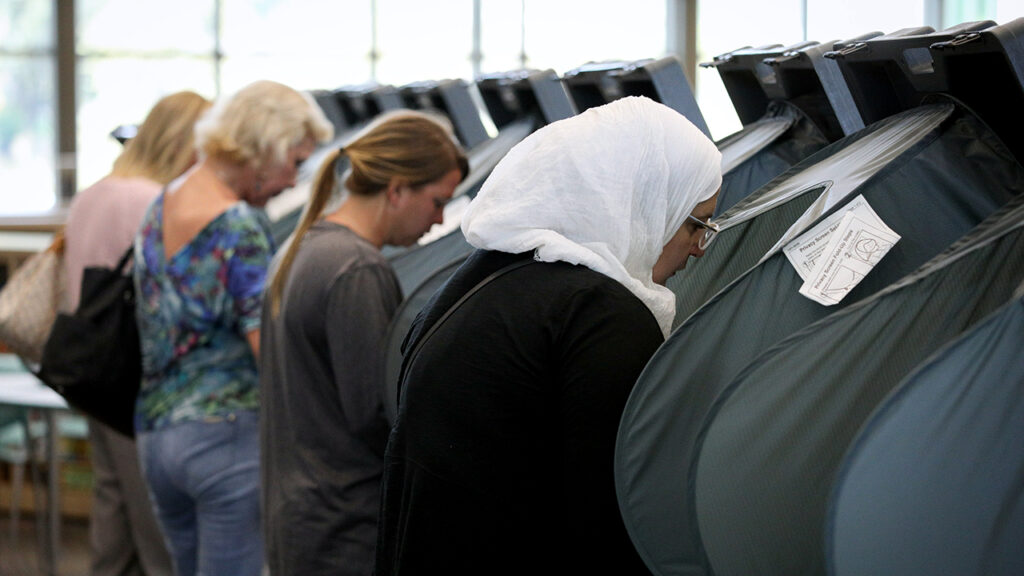Women Bearing Brunt of Pandemic Recession

Even a small shift toward Democrats among working class women could spell payback in battleground states.
In this pandemic election year, what’s going on with women, America’s largest voting block?
Exit polling in 2016 tallying women’s preferences showed Donald Trump handily beating Hillary Clinton by nine points nationally, and by even more in battleground states. Pollsters determined that women voters without college degrees preferred Trump by as many as 27 points.
Times have certainly changed. And with women prioritizing the economy over all other issues (health care comes in second), the pandemic’s effect on the economy and a failure of presidential leadership all but assure us that Trump’s standing among women has fallen.
The Female Recession
The coronavirus pandemic is disproportionately affecting women, especially working class women, women with children and women of color. With in-school instruction delayed and sporadic, and child care centers fighting for their existence (Forbes says 40% of all child care centers will close permanently without federal assistance, which doesn’t seem to be forthcoming), women are abandoning the workforce in record numbers…because “children come first.”
As lockdowns and stay-at-home directives were taking hold last spring, women lost more jobs than men because their work tended to be concentrated in the businesses hardest hit by the pandemic: leisure and hospitality, food and beverage, government, retail and transportation industries.

There’s also a thing called the “wage gap.” According to data from the US Census, a woman working a full-time, year-round job earns 81.6% as much as her male counterpart. This wage gap is expected to be 2 points wider when the pandemic recession mercifully goes away.
Aside from the historic nurturing role assigned to women, the kitchen table math is a no-brainer: Man makes more money. Woman stays home with the kids. According to the Bureau of labor Statistics, “women aged 25-54 are three times as likely as men to not be working due to childcare demands.”
You Came a Long Way, Baby
This is a just plain disappointing for all of us who cheered women’s progress from “Father Knows Best” to “The Feminine Mystique.” It gathered steam in the seventies, with developments such as The Pregnancy Discrimination Act of 1978, birth control, paid family leave and anti-sexual harassment laws and policies. American women have come a long way, baby, from the fifties, when only 30% were in the workforce to the peak year of 2000, when 60% of women had full-time jobs.
You can argue that women helped pull America out of the last recession–The Great Recession–by acting as “shock absorbers” to offset the family breadwinner’s job loss: increasing her hours at work, taking part-time jobs, whatever it took.
Long-Lasting Consequences
Pandemic-induced unemployment among women has both personal and societal implications. For women who were building careers, the erosion of job skills and technological changes will make reentering the workforce a tougher slog once a vaccine is available and schools reopen. Without a firm commitment to job training, women could be “mommy-tracked” to low paying, dead-end jobs.
On a larger scale, it’s a simple calculation: “Women make up more than half the workforce,” remarked Nicole Mason of the Institute for Women’s Policy Research. “If they stop working, that’s income and earnings that don’t get pumped back into the economy.”
Stephanie Aaronson of the Brookings Institution: “The economy grows faster when more women participate in the workforce.”

Payback Time
The 2020 election will be determined by the results of certain battleground states and by shifts in preference by certain demographic groups. To put it plainly, I believe this election will be won or lost by the preferences of the group most affected by the pandemic recession: white working class women, or women without a college degree, who overwhelmingly supported Donald Trump in the 2016 presidential election.
Recent polling in battleground states reveals that working class women either remain in Trump’s column, but by a much smaller margin, or that in some states, Democrat Joe Biden is winning the group outright.
In the final analysis, the president’s declining support among women is driven by three factors: Trump’s hateful, boorish behavior and the fact that these voters don’t disdain Joe Biden the way they did Hillary Clinton.
Oh, and don’t forget the coronavirus. Celinda Lake, a Democratic pollster, summarized working class women’s feelings toward pandemic politics:
They really, really believe COVID has threatened their families, and they see themselves as the protectors of their families, and they think [Trump] is making their job more difficult at every turn.
Celinda Lake
















































































































